3
The DC-8 Airborne Research Platform
The NASA DC-8, operated for scientific research since 1987, is the only research aircraft in the airborne fleets of the United States (see Table 2.1) and other countries that is both long-range and heavy-lift, making it particularly unique in the scope of research questions that it can be used to address. It is also configured and operated to accommodate the installation and operation of diverse instruments and instrument arrays.
Given the role the DC-8 aircraft has played in NASA’s airborne fleet for decades, it is important to consider broadly the evolution of this particular aircraft, other components of the fleet, and how airborne platforms have been historically leveraged to conduct Earth system science. This chapter provides context on the historic role of long-range, heavy-lift aircraft; the specifications of the DC-8 that have made it particularly conducive to Earth system science; comparisons to other aircraft that have some offerings similar to those of the DC-8; and information and data on usage of this aircraft over time.
For purposes of this report, a “large” or “long-range, heavy-lift” aircraft refers to an aircraft like the DC-8, which is defined in this chapter by a unique combination of endurance, range, payload weight and power capacity, flexibility in payload composition, altitude range and ceiling, and space to accommodate many investigators. “Large” is used interchangeably with “long-range, heavy-lift.”
3.1 HISTORIC ROLE OF LONG-RANGE, HEAVY-LIFT AIRCRAFT
Long-range and heavy-lift aircraft have served scientific research for many decades. Research aircraft have followed the growth in aircraft technology and capacity driven by passenger and freight demand and by advances in military needs. Long-range flights have been of value because of the size of Earth (40,000-km circumference) and because the oceans cover vast areas separating continents in both hemispheres. Heavy-lift research aircraft have carried large payloads of instrumentation, investigators, and fuel. Many instruments to acquire Earth observations have been large and heavy, especially in development and testing periods, and often require operators in flight. The need to acquire simultaneous and synchronized observations from multiple instruments in a payload has meant that research aircraft frequently operate at maximum takeoff weights. Consequently, research teams often have had to fly fewer instruments or people than they would like, reducing the scope of the research they would have liked to have achieved.
Long-range and heavy-lift aircraft have also allowed research missions to have multiple deployment sites. Acquiring global or hemispheric observations requires traversing the remote oceans with multiple landing sites drawn from a limited list of options. Long-range capability increases landing site options and also affords observation time en route to explore phenomena or divert from the great circle route to the chosen landing site. Heavy-lift capability accommodates the additional personnel, fuel, luggage, and replacement parts for the aircraft and instrumentation that are required when multiple landing sites are planned and the mission timeline is designed with limited downtime.
NASA's investment in long-range, heavy-lift aircraft predates the acquisition of the DC-8. A Convair 990 was operated as the Galileo flying laboratory after being acquired in the late 1960s. The Convair 990 is a four-engine passenger jet with a maximum altitude of 12.5 km (41,000 ft) and range of 6,100 km (3,300 nmi) with an 11,700-kg (25,800-lb) payload. Galileo became a major program at NASA's Ames Research Center in California with studies of wildlife migration, ice-floe movements, archaeological surveys, and the Indian monsoon. After a tragic mid-air collision destroyed Galileo I in 1973, it was replaced with Galileo II, also a Convair 990. Subsequent studies included atmospheric chemistry measurements and intercomparisons and remote optical measurements of the El Chichón volcanic cloud (Beck et al., 1987; Condon and Vedder, 1984; Pollack et al., 1991). In 1985, Galileo II was destroyed by fire without loss of life during an aborted takeoff at March Air Force Base in California. The loss of Galileo II set the stage for the acquisition of the DC-8.
The NASA DC-8 is a Douglas DC-8-72 aircraft acquired in 1987 to operate for research in Earth, atmospheric, and space sciences. The aircraft, built in 1969, is designated NASA 817 and is currently based at the NASA Airborne Science facility in Palmdale, California.
3.2 NASA DC-8 SPECIFICATIONS
The DC-8 is a four-engine jet transport aircraft that has been highly modified from its original commercial configuration to accommodate research instruments in the main fuselage, cargo bay, and on the wings (NASA, 2015; NASA Airborne Science Program, 2021). Upgrades to its four CFM56-2-C1 High Bypass Turbofan Jet engines enable greater range and altitude capability. The aircraft is 48 m (157 ft) long with a 45-m (148-ft) wingspan. With a flight duration of up to 12 hours, the nominal range is 10,000 km (5,400 nmi) at a ceiling cruise altitude of 12.5 km (41,000 ft). For shorter periods, the aircraft can operate at altitudes as low as 300 m (1,000 ft) over land and 150 m (500 ft) over open ocean. In flight, the minimum pressure in the cabin, cargo areas, and avionics bay is equivalent to that at a pressure altitude of about 2,300 m (7,500 ft). The instrument payload weight (instruments, consumables [e.g., gases], seats, etc.) is near 13,600 kg (30,000 lb). Including the additional weight of passengers and cargo, the total payload can be approximately 22,700 kg (50,000 lb) (Ozoroski et al., 2020). The substantial trade-offs between mission payload, fuel load, range, and maximum altitude
give the DC-8 important flexibility in meeting a wide range of mission requirements (Ozoroski et al., 2020).
In research flights, up to 42 experimenters and 8 crew can be safely accommodated (see Figure 3.1). The duration capability of the DC-8 has afforded experimenters opportunities to make extensive observations covering a broad latitude and longitude range that includes both polar regions and Southeast Asia, Europe, and Africa. The wide altitude range of the DC-8 gives researchers access to most of the troposphere for air, optical, or radar sampling. The upper troposphere in the tropics cannot be reached because of the high tropopause in the region. In contrast, the lower stratosphere is reached routinely at maximum cruise altitude during high-latitude flights. The altitude range allows for routine flight maneuvers that vertically profile from the surface to the upper troposphere or lower stratosphere.
The DC-8 has in-flight Iridium and Inmarsat satellite communications capability that allows in-flight communication with operations and science team members on the ground (NASA, 2011). Meteorological forecasts and satellite images uploaded in flight are used to modify flight plans and avoid or target weather systems along the flight track.

The aircraft also has a Data Distribution System for connecting information from onboard avionics systems, facility instrumentation, and experimenter equipment (NASA, 2011). This information is made available in real time to experimenters and crew on board and transmitted to the ground and broadcast to remote users via the internet. The combination of onboard data distribution and communication to the ground optimizes real-time flight planning and scientific analysis of real-time data that informs in-flight decisions to adjust the aircraft flight track or conduct in-flight maneuvers.
The DC-8 power systems provide power to the payload equipment as 400 Hz, 115 volt, AC or 60 Hz, 115 volt, of which a total of 80 kVA is available (NASA, 2011). Ground-based and in-flight air conditioning units maintain temperatures in the passenger and cargo areas.
The internal volume and length of the DC-8 affords optimal integration of complex instrumentation that can involve several racks of electronics, large lasers on optical benches, pumps, power supplies, and compressed gases or other consumables (e.g., liquid nitrogen). Flexible passenger seating available at most instrument stations allows experimenters to operate and observe their instruments in flight while safely seated and allows visitors and students to observe real-time instrument operation throughout a research flight. The DC-8 has a number of custom fuselage openings for ambient air sampling probes or window mounting for upward or downward optical access (Figures 3.2 and 3.3). The forward and aft cargo bays have large, approximately 1-m2 openings for mounting in situ or remote sensing instruments and more than 20 window openings are available on either side of the aircraft fuselage. The aircraft’s original windows can also be replaced with custom aluminum plates for ambient air or optical sampling.
The versatility of the DC-8 to accommodate customized instrumentation suites and flight requirements is demonstrated here through three examples of completed missions.
First is the use of Airborne Synthetic Aperture Radar (AIRSAR) for studies of Earth’s surface properties and processes as part of NASA’s AIRSAR program.1 Collecting synthetic aperture radar (SAR) data at several bands required a large platform such as the DC-8 because SAR then weighed 1,720 kg, drew 10 kW of power, and consisted of 13 electronics racks and several large antennas that covered a large area of the aircraft outer surface. NASA’s DC-8 was used to collect SAR data to study Earth surface dynamics, snow and frozen ground, and geological hazards and disasters from 1988 to 2004. Mounted on the modified DC-8, AIRSAR hosted multiband SARs capable of collecting fully polarimetric SAR data at three wavelengths (C-, L-, and P-band) to characterize the dielectric and roughness properties of terrains needed to study landscape types and changes. This side-looking radar was typically flown at an altitude
___________________
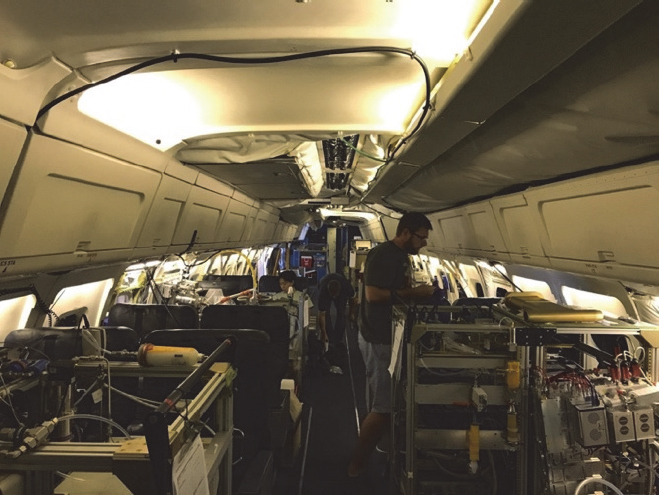
of 8 km above the ground surface and average speed of 215 m per second. Using dual antennas, AIRSAR also acquired singe-pass cross-track interferometric synthetic aperture radar (InSAR) data for surface topography mapping and single-pass along-track InSAR data for measuring ocean surface currents. The suite of sensors can be best fitted in a large aircraft such as the DC-8 that allows space to mount two or more separate antennas and a clear radiating path for them. Particularly, high-precision topographic mapping from single-pass InSAR requires large spatial separation of the two SAR antennae, which are also best accommodated by a large aircraft. In addition, SweepSAR development flights were conducted on the DC-8 during March and July 2011. SweepSAR utilizes a unique scanning mode of the receiving antenna to expand the scanned area.2 Subsequent redesign of the AIRSAR system has allowed this science area to focus primarily on the installation and use of SAR on smaller aircraft (see Section 2.5d).
The second mission is Operation IceBridge (OIB), a series of eight DC-8 missions from 2009 to 2019 that provided study and monitoring of Arctic and Antarctic ice sheets
___________________
2 See https://nisar.jpl.nasa.gov/mission/get-to-know-sar/sweepsar/.
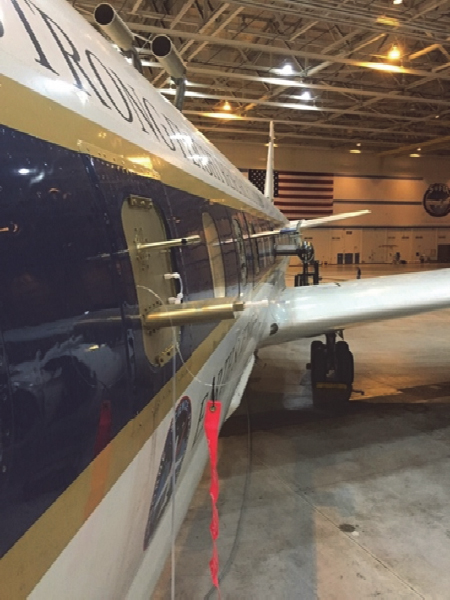
(Figure 3.4). The missions were initiated as a gap filler between the end of the NASA Ice, Cloud, and land Elevation Satellite (ICESat) in 2009 and the launch of the ICESat-2 satellite in 2018. The DC-8 was one of several aircraft used for the OIB surveys, which also included the NASA P-3. The DC-8’s combination of long-range (10-12 hours’ duration) and cruising altitude capabilities made it particularly useful for flights over Antarctica (Figure 3.5). The NASA P-3 and DC-8 aircraft have comparable flight endurances, but the DC-8’s speed advantage in transit to the science target region allowed it to cover approximately three times more surface area per mission than the P-3.
The core OIB payload consisted of four instrument suite technologies: Airborne Topographic Mapper (a laser altimetry system with several electro-optical cameras) from the NASA Wallops Flight Facility, a gravimeter from Lamont Doherty Earth Observatory, ice- and snow-penetrating radars from University of Kansas, and Digital
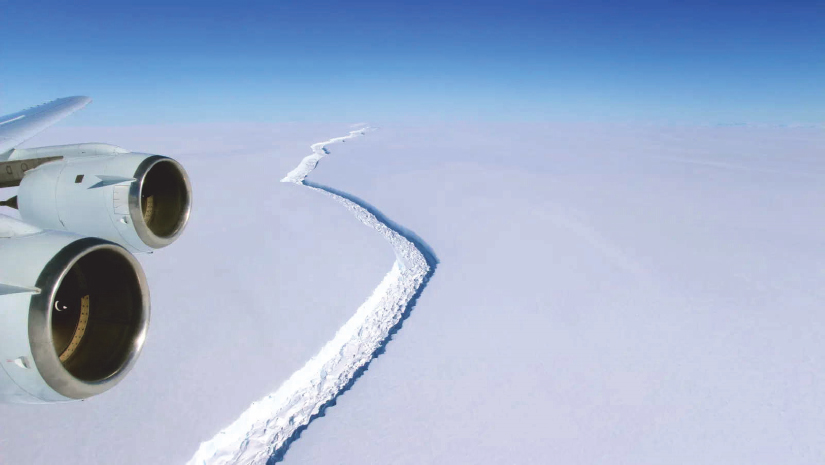
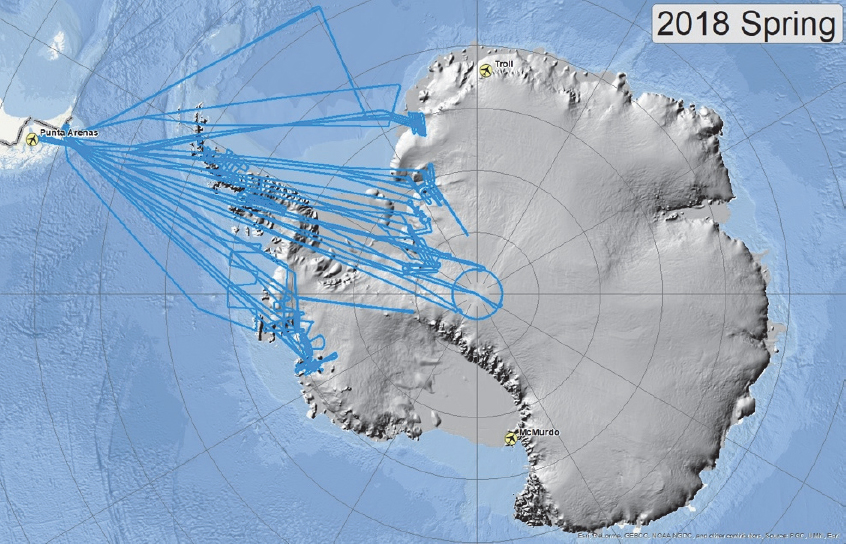
Mapping System/Position and Orientation System (an electro-optical camera with differential global positioning system georeference and registration system) from the sensor facility at the NASA Ames Research Center. Each campaign also carried several non-core instruments that took advantage of an opportunity to collect data in the Arctic and Antarctic. The weight of the DC-8 instrument payload on OIB flights varied between 6,800 kg (15,000 lb) and 8,600 kg (19,000 lb).
The third mission is the NASA atmospheric chemistry study, the Atmospheric Tomography mission (ATom). The DC-8's combination of long-range, heavy-lift, and vertical profiling is demonstrated by the four deployments of ATom from 2015 to 2018 (NASA, 2020c). Figure 3.6 shows an example deployment comprising 14 consecutive flights beginning and ending in Palmdale, California, and covering 90,000 km (48,600 nmi), with the most southerly flight from Punta Arenas, Chile, that reached the Antarctic continent. This deployment included more than 180 vertical profiles between near the ocean surface and cruise altitude. The ATom payload included 27 in situ instruments providing measurements of 300+ chemical species and ambient parameters (NASA, 2020a). Figure 3.3 shows some of the custom inlet assemblies on the port side of the DC-8 during the ATom Mission that allow for ambient sampling of atmospheric composition.
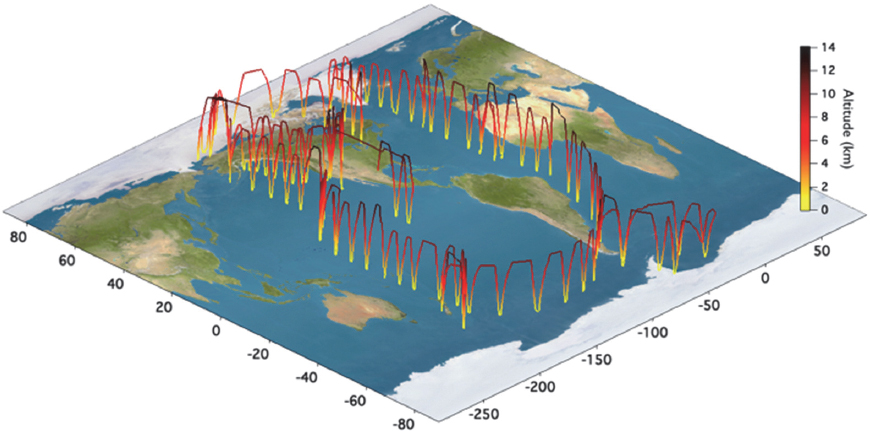
3.3 COMPARISONS OF THE NASA DC-8 WITH OTHER RESEARCH AIRCRAFT
The unique combination of specifications of the DC-8 is outlined in this section and compared with other principal research aircraft in the U.S. fleet (see Figure 3.7).
Principal distinguishing features of the NASA DC-8 include the following:
Payload weight. The DC-8 instrument payload (13,600 kg [30,000 lb]) and total payload (22,700 kg [50,000 lb]) exceed that of any other research aircraft. The C-130 with the next largest payload (10,400 kg [23,000 lb]) has a shorter range and lower altitude ceiling. The Gulfstream V (GV) payload is a factor of 3-4 smaller and highly dependent on range for a specific flight.
Payload flexibility. In addition to large weight capacity, the DC-8 has significant payload flexibility with available power (80 kVA), multiple diverse access ports, large and complex external inlets, and a cargo bay for support equipment (e.g., pumps, gases, power supplies). No other research aircraft has these combined specifications.
Flight passengers. The passenger and crew capacity of the DC-8 (50) exceeds that of any research aircraft, allowing for experimenters, students, and observers.
Altitude range. The altitude ceiling of the DC-8 (12.5 km [41,000 ft]) is exceeded only by the GV (15.5 km [51,000 ft]), when stratospheric aircraft are excluded. The DC-8 can also fly close to the surface (both land and ocean) similar to other smaller lower-altitude aircraft.
Range. Only the GV has a comparable range (10,200 km [5,500 nmi]) to the DC-8 (10,000 km [5,400 nmi]). The NASA Global Hawk has a larger range in unpiloted stratospheric flights.
Vertical profiling. The DC-8 is able to conduct routine vertical profiling from near the surface over oceans (150 m [500 ft]) to cruise altitudes near 12.5 km (41,000 ft).
Mobile deploy. The DC-8 can carry a comprehensive payload, along with freight (spares, luggage) and personnel across long distances (and oceans) with multiple landing stops to obtain global-scale observations over several weeks. In other words, cargo capacity enables long-range sampling from multiple bases of operation.
With wing-mounted engines, inlet structures on the DC-8 fuselage pose no risk to engine operations in flight, as is also true for the C-130 and P-3 Orion. The GV does not have a flexible option for window-mounted inlets for most in situ sampling missions due to the need to avoid risk to the fuselage-mounted engines rearward and in line with the windows. This concern limits inlet mounting options to fewer upper and lower fuselage locations and the tail section. These inlet locations also require longer sampling lines than what is afforded by a window inlet, which is a challenge for measuring reactive and sticky gases.
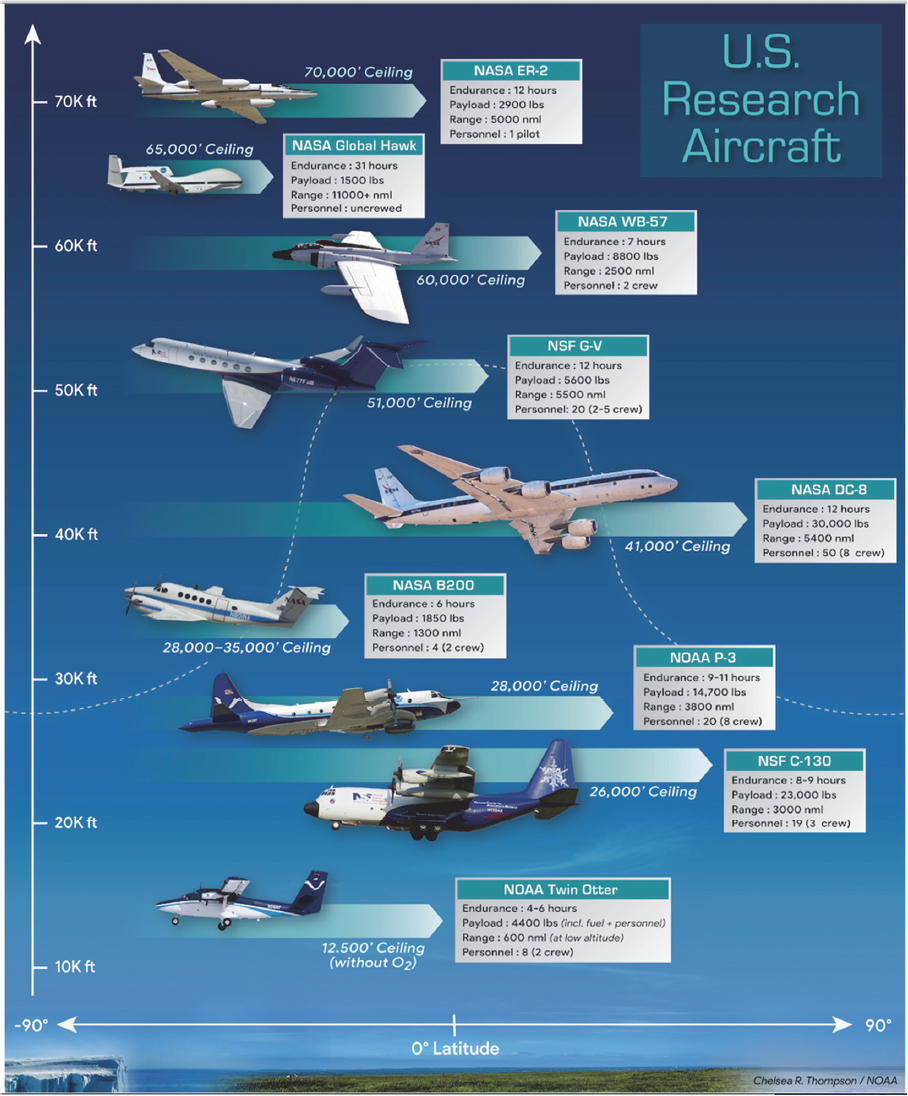
Unlike the DC-8, modern aircraft such as the GV have a monocoque design in which the fuselage skin absorbs the mechanical stress loads of the structure. For these designs, altering the aircraft skin with access ports or adding underwing pylons generally requires substantial stress analysis, a more complex modification process, and strict size and weight limitations due to the changes in stress caused by such modifications. The limitations for skin or wing modifications have been far less for the DC-8 and similarly designed aircraft.
Underwing pylons on the DC-8 provide locations for mounting and operating small sensors (NASA, 2011). A pylon located near each wing tip can carry one or more instruments weighing 45 kg (100 lb). The pylons are far removed from flow around the fuselage and large wing sections, and from the engine intakes. Wing-tip sampling minimizes biases in sampling cloud and other large particles. Power and communication wiring connect these payload locations to the fuselage payload area.
Remote sensors mounted on the DC-8’s upper fuselage have a full sky view interrupted only by the vertical tail. In contrast, high mounting of the horizontal stabilizers on the vertical tail structure, for example on the GV, interferes substantially with a full sky view that is critical for radiation measurements in particular (compare aircraft structures in Figure 3.7).
Conclusion 3.1. The DC-8 has a unique and powerful combination of features to support research activities in comparison to other available aircraft. These include long range, high-altitude ceiling, vertical profiling capability, large payload weight, inflight seating, in-flight communications, and instrument payload integration and operation flexibility.
3.4 NASA DC-8 HISTORIC USAGE
3.4a Characteristic Statistics
Evaluating past usage of the DC-8 illustrates key characteristics for the aircraft to achieve NASA Earth system science goals (Figure 3.8). Since use of the DC-8 began in 1987, the aircraft has flown 11,745 mission flight hours during more than 140 airborne campaigns (Chris Jennison, NASA; Hilsenrath, 2020). The average of 355 hours of science flights per year (nearly 1 hour per day) illustrates the hardiness of this platform over its 30+ years. The total flight hours in a given campaign depend on the complexity of payload integration, the required hours in each flight to achieve the mission objectives, and the required time between flights to service the payload and conduct flight planning. Campaigns on average included at least one 8-hour flight, and an average range for a science flight of 5,400 km (2,900 nmi). In some campaigns the average flight exceeded 10 hours in duration. Almost all missions leveraged the ability to reach nearly 12.5 km (41,000 ft), with many leveraging the ability to regularly profile between the
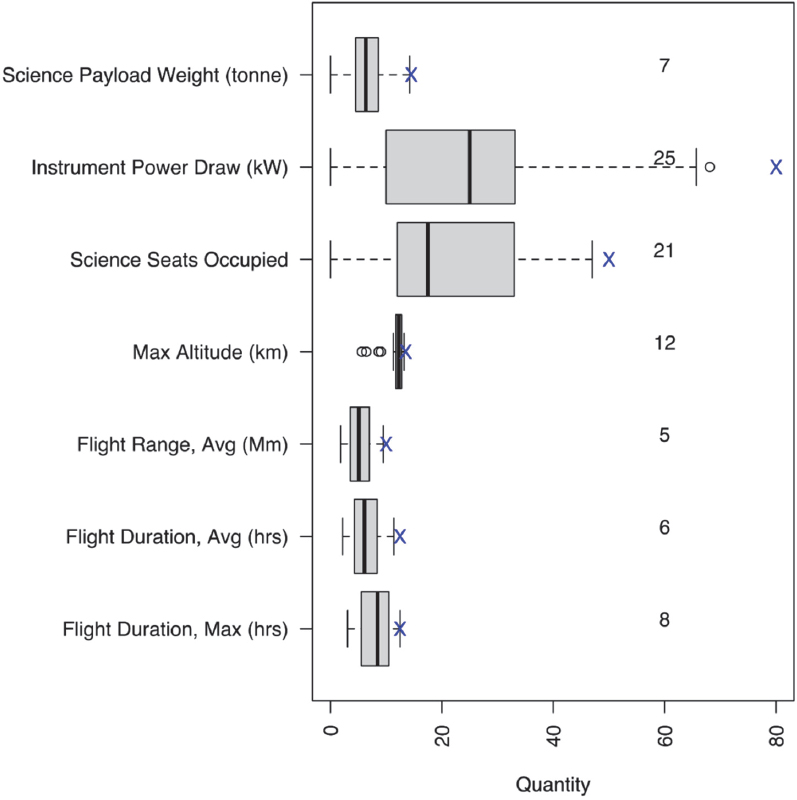
surface and maximum altitude. Campaigns averaged science payloads of 6.8 tonnes (15,000 lb), with power draw of 25 kW and 21 occupied science seats. Campaigns regularly reached more than 30 scientists, 30 kW, and 9,100 kg (20,000 lb, 3rd quartile). These statistics indicate that the Earth system science research community has been using the DC-8’s full range of capabilities.
Conclusion 3.2. The DC-8 has conducted more than 140 airborne campaigns since 1987 with a wide range of scientific and technical objectives. The usage statistics indicate that the DC-8 capabilities have been critical features of the campaigns.
3.4b Hours per Application
An assessment of historic usage over the past three decades shows that three science applications have used the DC-8 aircraft most heavily: atmospheric chemistry, cryosphere, and AIRSAR studies. Weather, instrument development, and aeronautics also have a significant history of usage, with other areas, such as one-time campaigns, training, and outreach, comprising smaller past usage.
Use of the DC-8 since its acquisition has been sustained in flight hours but has also evolved considerably in terms of which applications use it most heavily. To demonstrate this evolution, Figure 3.9 provides total flight hours across seven NASA funding categories over the past three decades. Two particularly heavy users of the platform are AIRSAR flights in the Earth's surface and interior category and OIB flights in the cryosphere category. The peak flight periods are separated from each other in time with AIRSAR flights from 1987 to 2004 and OIB flights from 2008 to 2018 (see also Section 3.2). Early flights focused on instrument development and then the use shifted to include satellite evaluation and science campaigns focused on a range of Earth surface characteristic questions, often including studies of ecosystems. AIRSAR’s use on the DC-8 ended after 2004 when its replacement—the smaller, lighter Uninhabited Aerial Vehicle Synthetic Aperture Radar—began being deployed on smaller aircraft (see Section 2.5d). Cryosphere studies using the DC-8 emerged as part of OIB. While the OIB campaigns were an unanticipated airborne science need, the DC-8 was particularly valuable in enabling repeated long-duration airborne surveys of the Antarctic ice sheet and surrounding sea ice.
Atmospheric composition has accounted for the most sustained use of the DC-8 with 27 field studies from 1987 to 2019. This sustained use has come with substantial evolution in the capacity to address the science of atmospheric composition both in terms of the instrumentation comprising DC-8 payloads and the scientific scope of field studies. Discussed in more detail in Section 4.1c, the temporal frequency of measurements and number of constituents sampled have enabled increased detail in exploring nonlinear photochemical processes, source fingerprinting of emissions, and exploration of fine gradients in chemistry around thunderstorms and in fire plumes. Advances in satellite observations and atmospheric models have also evolved and benefited from these advances in DC-8 measurement capabilities. With the international constellation of satellites observing global air quality coming into full fruition in the next decade, sustained use by the NASA atmospheric composition community in partnership with the international community is assured.
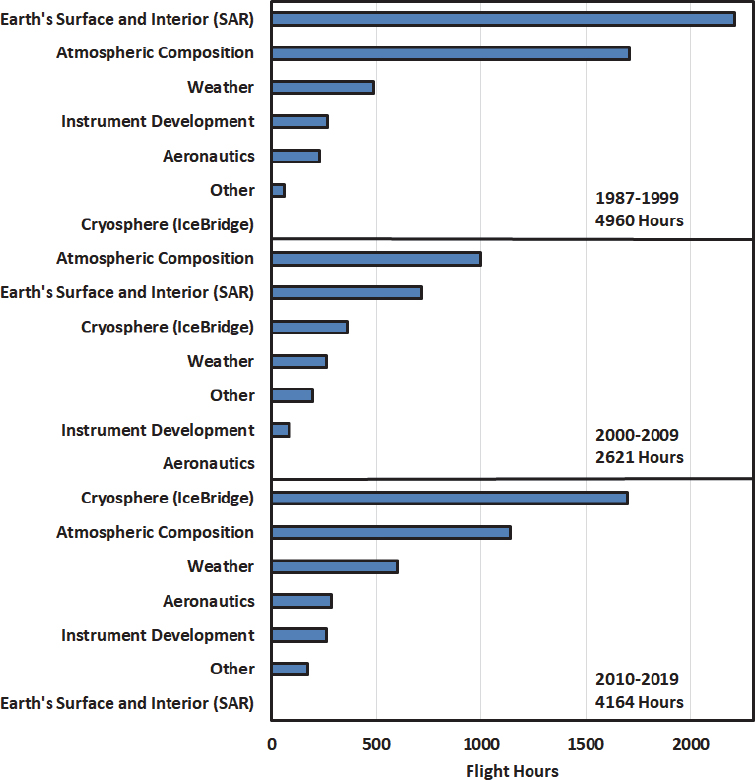
When atmospheric composition is combined with weather, the second-most sustained user with 14 field studies from 1992 to 2017, general atmospheric sciences have accounted for 44 percent of DC-8 flight hours. This amount is essentially equivalent to AIRSAR/Cryosphere use at 43 percent. The remaining 13 percent includes aeronautics, instrument development, and other uses. The pattern of aeronautics use is directly related to funding, which was strong in the 1990s (Atmospheric Effects of Aviation Project) before being eliminated in the 2000s and reemerging as a priority area in the past decade and expansion to include green aviation research (Moore et al., 2017).
Instrument development has consistently used the DC-8, with 20 campaigns from 1989 to 2017. These studies tend to require fewer flight hours, but they come with significant
payload integration needs that the DC-8 can accommodate for state-of-the-art instruments, such as lidars, radars, and radiometers, that are still in a demonstration mode.
The Other category includes flights in support of NASA’s annual Student Airborne Research Program (SARP), for which the DC-8 offers a good environment for introducing students to airborne science. Specific benefits of SARP are discussed in more detail in Chapter 5. The Other category also accounts for a number of unanticipated one-time campaigns spanning science areas including Astronomy, Oceanography, and Topography.
Some additional insight comes from an analysis of Earth Venture Suborbital (EVS) proposals submitted over the past decades to three solicitations with awards in 2010, 2014, and 2018. Although only a few proposals can be selected, the potential for a 5-year, $30 million award attracts a broad response from across the Earth system science community. These proposals represent a valuable indicator for airborne science needs and areas of Earth system science for which groups of scientists are actively developing airborne science investigation concepts. Response to EVS solicitations resulted in 20 requests for the DC-8, second only to the NASA P-3B with 23 requests. Figure 3.10 shows how these requests were distributed across science focus areas. Consistent with the historical use statistics in Figure 3.9, the largest number of requests comes from atmospheric composition and weather. The other nine requests, however, represent science areas that have not had recent or regular use of the DC-8. Although the committee knows neither how the DC-8 was proposed to be used nor whether a smaller aircraft could have been proposed instead, these requests suggest that the broader science community values the DC-8 and wants to use at least some of its capabilities.
Conclusion 3.3. Three science applications have used the DC-8 aircraft most heavily: atmospheric composition, cryosphere, and SAR studies. Weather research, instrument development, and aeronautics also have a significant history of usage, with other areas, such as training and outreach, comprising smaller past usage. Atmospheric composition has accounted for the most sustained use of the DC-8 with 27 field studies from 1987 to 2019 followed by weather with 14 field studies from 1992 to 2017.
Conclusion 3.4. The research uses of the DC-8 platform have evolved over its decades of operation in ways that could not be anticipated, indicating its fundamental flexibility and value. Important examples are flights to develop SAR before the technology reached maturity and no longer needed a heavy-lift aircraft, and to use for Antarctic ice surveys when a key gap occurred in satellite remote sensing coverage.
The projected use of the DC-8 for studies focused on remote sensing of Earth’s surface is minimal for at least three reasons. First, miniaturization of remote sensing instruments resulted in scientists studying Earth’s surface properties and processes turning to alternative aircraft. Second, scientists chose smaller aircraft because the operating cost of the DC-8 is higher than that of smaller aircraft, especially when single or a few miniaturized instruments flown on individual smaller aircraft can accomplish the science objectives. Third, based on comments from committee members, workshop speakers, and the Earth system science community, scientists studying Earth’s surface stopped thinking about using the DC-8 because they shared a real and widespread perception that the DC-8 would not be available for their use due to its frequent demand by atmospheric chemistry and weather.
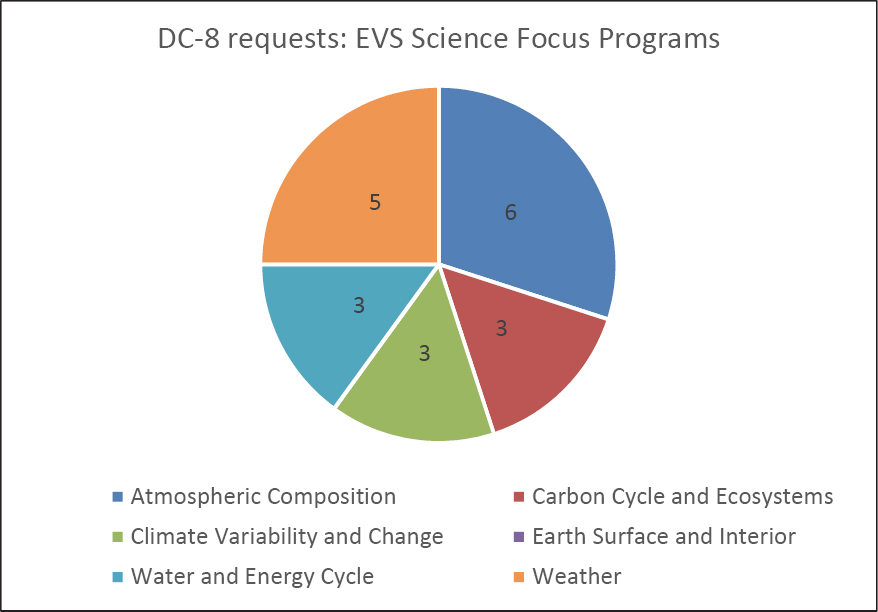
Conclusion 3.5. Miniaturization of remote sensing instruments, lower deployment costs of smaller aircraft, and the perception that the DC-8 was not available are three of the reasons that scientists studying Earth’s surface properties and processes have
designed their research strategies using smaller aircraft and have not seriously considered using the DC-8 for their research.
3.5 CHARACTERISTICS OF A FUTURE LARGE AIRCRAFT
The eventual decision to replace the DC-8 with another large aircraft will be based in part on the past success of the DC-8 missions and the need for future large-aircraft missions expressed by a range of science disciplines (see Chapter 4). The committee concludes that the combined characteristics of a long-range, heavy-lift replacement aircraft, especially for payload, range, and ceiling altitude, are likely to be similar to those of the DC-8 described in detail in previous sections of this chapter. However, the committee encourages that consideration be given to enhancing one or more characteristics of the DC-8 as outlined in the discussion in this section, with the goal of optimizing the platform capabilities for its expected future Earth system science missions (see Recommendation 2 in Chapter 6).
The core characteristics of a replacement large aircraft are payload, range and duration, and altitude ceiling:
-
Instrument payload weight. Although some past DC-8 instrument payloads reached the maximum weight allowed (13,600 kg [30,000 lb]), the average was significantly less (6.8 tonnes [15,000 lb]; Figure 3.8). The general trend to smaller and lighter instrument weights driven by new technologies may lower the average in the future. However, future instrument and total payloads for some science areas and increasingly interdisciplinary research in the future are likely to require similar or greater maximum weight capacity.
- The total payload of the DC-8 currently includes in-flight seating for about 42 passengers in addition to crew. Passengers, primarily researchers operating instruments or supporting flight science, have been essential in past missions, which have carried less than 20 passengers on average (Figure 3.8). Passengers also include students and observers, which will likely be important for increasingly interdisciplinary missions in the future. Seating capacity also aids workforce recruitment, training, and development goals related to Earth system science disciplines. Larger payloads also afford more flexibility in the distribution of payload among instruments, passengers, and cargo.
- The total payload of the DC-8 includes cargo beyond the instrument and passenger payload such as spares, luggage, and service equipment. A large allowance for cargo affords flexibility for missions that require mobile deployment options.
- Flight duration and range. The DC-8 range and duration characteristics are 10,000 km (5,400 nmi) and 12 hours, respectively, depending on payload and weather conditions, while the average values in past missions are near 50 percent of these values (Figure 3.8). These values are required to reach and survey remote regions, such as Antarctica, or to observe processes, such as weather, that change on the timescale of a day. Future missions may benefit if the maximum range were to be extended, especially for operations traversing remote oceans or polar regions or conducting intensive sampling in such regions. However, as mission duration is increased, the limitations set by pilot/crew rest and science team capacity become more important.
- Altitude ceiling and vertical profiling. The altitude ceiling of the DC-8 of 12.5 km (41,000 ft) affords sampling of the upper troposphere and the lower stratosphere region in mid-latitudes and polar regions and only into the upper troposphere in the tropics. This limit affords substantial in situ vertical profiles to test remote sensing column measurements of atmospheric composition or to allow remote sensing surface observations over large geographic swaths. In contrast to payload and range, the DC-8 operated near maximum altitude on average in past missions (Figure 3.8), in part because operational efficiency increases with altitude. Some future missions may benefit from a higher altitude. For example, a higher ceiling altitude would allow sampling in the tropics in the upper troposphere and in the transition layer into lower stratosphere, and sampling deeper into the lower stratosphere in polar regions.
Performance trade-offs are an essential aspect in specifying the characteristics of a replacement large aircraft. Trade-offs exist between the core characteristics of payload, range and duration, and altitude ceiling for the DC-8 and essentially all aircraft (Ozoroski et al., 2020). For example, maximum takeoff weight includes fuel and total payload while maximum range and altitude ceiling depend on takeoff weight and in-flight weight (as fuel is consumed during flight), respectively. Figure 3.11 shows how the DC-8 range depends on payload, fuel, and maximum takeoff weight. Thus, any significant departure from the core characteristics of the DC-8 will require in prospect a careful evaluation of NASA priorities for aircraft performance and how potential changes in performance might affect achieving future mission science objectives.
The success of the DC-8 missions since 1987 have relied on NASA infrastructure resources that have provided DC-8 with excellent engineering, operations, and maintenance support teams. The successful deployments of a DC-8 replacement aircraft would similarly depend on having highly qualified support teams.
An equally valuable aspect of the DC-8 has been the ease with which complex payloads have been accommodated, affording great flexibility to enable new and changing instrument requirements.
- Instrument payload flexibility. The DC-8 provides a high degree of flexibility in integrating, testing, and operating complex instrument payloads. These features include available instrument mounting racks, multiple diverse sample and access ports along the fuselage sides as well as the top and the bottom, external inlet mounting, multiple underwing pylons that sample unperturbed flow, and a cargo bay. Substantial payload power is available (about 80 kVA). In-flight seating near installed instruments is generally available for operators. The expected increase in remote operation of payload instruments (via satellite communications) will add flexibility and reliability to payload operations in flight. This overall flexibility is required to accommodate current suites of multiple mission-critical instruments, both remote sensing and in situ, with their diverse aircraft location and sampling needs, and to allow for future instruments and their optimal sampling strategies.
In assessing the attributes of a replacement aircraft, other valuable features that need to be considered for research aircraft in general include the following:
- Durability. Durability is related to minimal maintenance downtime, operations in adverse weather conditions, and the ability to fly a series of frequent and sometimes back-to-back flights. Durability is essential to minimize the cancellation of scheduled time-sensitive missions due to unscheduled maintenance; to enable observations in regions with challenging weather conditions, such as flights from high-latitude airports; to sample the many processes and events that occur over several days; to do surveys over large regions efficiently; and to observe infrequent events that occur with little warning during a mission.
- Precision autopiloting. Precise flying is needed to measure minute changes in surfaces and their properties by repeated observations over days to weeks or to provide in situ observations useful for satellite testing.
- In-flight satellite communication links to operations on the ground. Satellite communication links are necessary to optimize flight observation strategies by providing two-way information exchange between the aircraft and science operations centers on the ground and to enable broader participation in mission flights by observers on the ground.
Conclusion 3.6 The combined characteristics of a long-range, heavy-lift replacement aircraft, especially for payload and range and ceiling altitude, are very likely to be similar to those of the DC-8 described in this chapter. In choosing a replacement aircraft, consideration may be given to enhancing one or more characteristics of the DC-8 with the goal of optimizing the aircraft capabilities for its expected future Earth
system science missions. Performance trade-offs are an essential aspect of all aircraft operations. Thus, any significant departure from the core characteristics of the DC-8 would require in prospect a careful evaluation of NASA priorities for aircraft performance and how potential changes in performance might affect achieving future mission science objectives.
3.6 CANDIDATES FOR A FUTURE LARGE AIRCRAFT
Several operational aircraft can be considered candidates for replacing the DC-8. The study by Ozoroski et al. (2020) was commissioned by NASA to consider the technical challenges of replacing the DC-8 and to evaluate options for a more sustainable aircraft and one that would enhance capability while lowering risk. After collecting available data, the study developed performance models for the seven aircraft shown in Table 3.1. This very comprehensive study provides an extensive narrative of aircraft features and performance, and further analyzes aircraft performance in three airborne science missions of relevance to anticipated future DC-8 missions. The missions include typical DC-8 payload weights ranging from 13,600 to 23,600 kg (30,000-52,000 lb) and typical mission ranges up to 9,400 km (5,050 nmi). The study concludes that a Boeing 767-200ER aircraft could meet and enhance all of the existing DC-8 capabilities, notably offering greater payload, extended range, additional experimenter floor-space, and generally reduced operating costs. Thus, operating a 767-200ER would avoid the need to make trade-offs in key performance features as discussed in this section.
Table 3.1 Reference Weights and Ranges for Several Operational Long-Range and/or Heavy-Lift Aircraft That Are Candidates to Replace the DC-8
| Reference and Model Weight, lb | G-V | 737-900 | P-8 | DC-8-72 | 767-200ER | A3 30-200 | 777-200LR | |
|---|---|---|---|---|---|---|---|---|
| Max Payload plus Fuel | Cal-1* | 90,815 | 188,200 | 188,200 | 335,627 | 387,942 | 514,673 | 767,283 |
| Max Fuel plus Payload | Cal-2* | 90,815 | 188,200 | 188,200 | 335,627 | 387,942 | 514,673 | 767,283 |
| Max Fuel plus OEW | Cal-3* | 87,815 | 144,557 | 164,367 | 315,467 | 343,290 | 507,032 | 670,146 |
| Max Fuel Volume (gal) | 6,151 | 6,875 | 10,951 | 24,219 | 24,131 | 35,990 | 47,783 | |
| Max Jet A US Fuel Wt | 41,215 | 46,062 | 73,372 | 162,267 | 161,680 | 241,132 | 320,146 | |
| Max Jet A1 Fuel Wt | 40,533 | 45,300 | 72,158 | 159,582 | 159,005 | 241,132 | 314,849 | |
| Fuel Wt with Max Payload | 36,315 | 38,900 | 38,900 | 127,627 | 127,942 | 139,887 | 306,283 | |
| Max Zero Fuel Wt, ZFW | 54,500 | 149,300 | 149,300 | 208,000 | 260,000 | 374,786 | 461,000 | |
| Operating Empty Wt, OEW | 46,200 | 98,495 | 90,995 | 153,200 | 181,610 | 265,900 | 320,000 | |
| Max Payload | 8,300 | 50,805 | 58,305 | 54,800 | 78,390 | 108,886 | 141,000 | |
| Payload Wt with Max Fuel | 3,400 | 43,643 | 23,833 | 20,160 | 44,652 | 7,641 | 127,137 | |
| Range Calibration Results | * | G-V | 737-900 | P-8 | DC-8-72 | 767-200ER | A330-200 | 777-200LR |
|---|---|---|---|---|---|---|---|---|
| Range 1: @ Max Payload plus Fuel | 5,371 | 2,040 | 2,602 | 4,374 | 4,849 | 4,254 | 7,477 | |
| Range 2: @ Max Fuel plus Payload | 6,440 | 2,602 | 4,961 | 6,211 | 6,725 | 9,037 | 7,954 | |
| Range 3: @ Max Fuel plus OEW | 6,703 | 3,457 | 5,767 | 6,741 | 7,839 | 9,100 | 9,514 | |
SOURCE: Ozoroski et al., 2020.
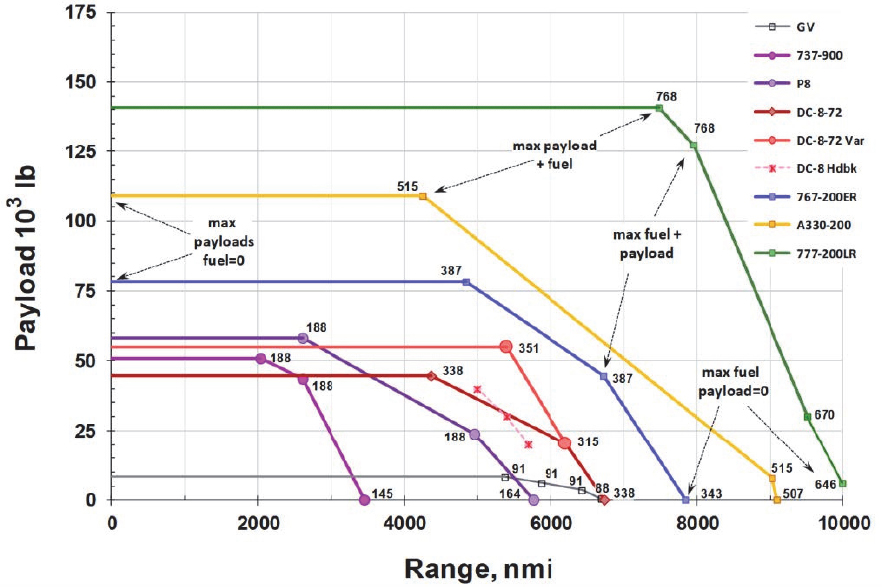
Two other aircraft in Table 3.1 also meet and exceed the DC-8 long-range and heavy-lift performance specifications, namely the Airbus A330-200 and the Boeing 777-200LR. The data in Figure 3.11 show maximum payloads of 49,000-64,000 kg (108,000-141,000 lb), respectively, far above that of the DC-8. At current DC-8 payloads of 13,600-23,600 kg (30,000-52,000 lb), the range is extended by 30-50 percent beyond the DC-8 range, respectively, representing substantial enhancements over DC-8 basic performance.
All three aircraft candidates are suitable for deep vertical profiling from near-surface to cruise altitudes (Ozoroski et al., 2020, fig. 8). The maximum altitudes during a profiling flight exceed those of the DC-8 for the same payload. For the 777-200LR, the additional altitude is approximately 1.5 km (5,000 ft) or greater throughout multiple profile maneuvers conducted as fuel weight decreases.
The 777-200LR is an approximately 18-hour aircraft with a DC-8 payload, corresponding to a range of approximately 17,600 km (9,500 nmi) in Figure 3.11. With this range of 43 percent of Earth's circumference, the flight plans to achieve objectives of future airborne missions can be similarly expanded. Immediate options, for example, are conducting zonal (east-west) sampling missions that cross the world's oceans or land masses to follow the transport of pollution from source regions to receptor regions while investigating chemical transformations. Flights could then take place over larger land-based and oceanic regions in both hemispheres, with fewer refueling stops. Disaster zones inside and outside the United States could be reached more easily and quickly from the United States to conduct investigations, and both polar regions could be sampled more comprehensively and safely.
Conclusion 3.7. A NASA-commissioned study identified aircraft that have performance specifications comparable to or greater than the DC-8. The evaluation shows that the specifications of three aircraft, the Boeing 767-200ER, Airbus A330-200, and Boeing 777-200LR, exceed the long-duration, heavy-lift specifications of the DC-8. These operational aircraft could not only replace the DC-8 but also enhance the capability to conduct a wide variety of airborne science missions.






















